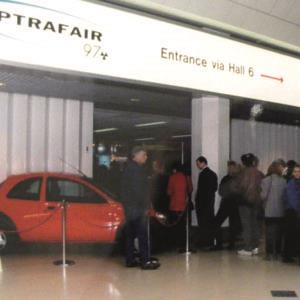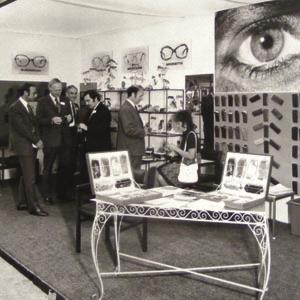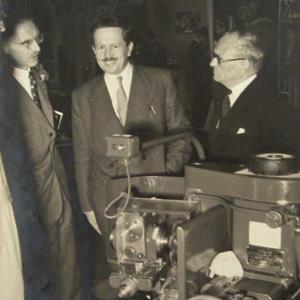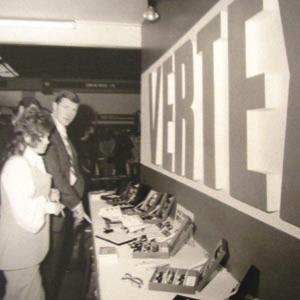As FMO celebrates exactly 100 years since its founding as the Association of Wholesale and Manufacturing Opticians (AWMO) in March 1917, it is timely to reflect on the huge progress that has been made in the UK ophthalmic industry in a relatively short space of time.
In the early 1900s almost every pair of spectacles was handmade to order for each patient. AWMO was founded to represent the industry at a time when the era of the craft of spectacle making was drawing to an end as the industrial revolution had facilitated the introduction of mass-production techniques for producing spectacle frames and lenses. And there were instrument innovations too, with the first hand-held direct illuminating ophthalmoscope, invented in 1915, enabling ophthalmoscopy to become one of the most ubiquitous medical screening techniques in the world today. But in the aftermath of the First World War, UK manufacturers complained bitterly that German manufacturers’ costs were a third of their own, and those in the US were 68 per cent lower, creating unfair competition in home and export markets.
By the early 1920s the industry was growing rapidly aided by innovations like the focimeter, which was invented in 1849, as well as bifocal lenses (although products in the 1920s still included eyeglasses and pince-nez). Improvements included pad bridges and side-end covers made of Shelltex, one of many new synthetic materials which would have a powerful influence on optical products in the following decades.
As the 1930s approached, while there is little evidence that frames were seen as fashion items, there was a growing awareness that new materials and new technologies could make spectacle wearing more enjoyable and the market expanded with the population increase. The earliest record of AWMO members exhibiting their products was at the 300th anniversary of the Worshipful Company of Spectacle Makers in 1929 and in 1933 AWMO held an instrument exhibition at a convention for the leading optical thinkers of the day.

With the threat looming of the Second World War, AWMO was among the first organisations in optics to address the potential impact of the war on its members, seeking an audience with government in January 1939 to discuss contingency plans. The Joint War Emergency Committee was formed, and former AWMO chairman Harry Lambert was its secretary. The committee worked hard to predict demand patterns and ensure that increasingly scarce material stocks were allocated where they could be of most use. But inevitably the war took its toll; plastic frames were in desperately short supply and most people whose frames failed to last out the war could only obtain military pattern metal frames. Lenses were made only to the nearest 0.50 dioptre, and although bifocals could still be obtained, orders took months to complete.
After the war, life slowly returned to normal, and the Goldmann perimeter, one of the most important contributions to modern perimetry, was developed in 1945. The NHS was founded in 1948 and sight tests and spectacles (to an agreed list of frame patterns) were free for everyone. While the patterns were later seen as utilitarian, to a population still subject to rationing and who had had no access to anything other than metal frames for years, the choice of styles and colour was welcomed and orders passed eight million pairs in the first full year of NHS operation. These were heady days for new suppliers who could prove their capacity to join the approved suppliers’ lists, and many FMO members owe their origins to those days.
In 1950 the government decided the cost of free spectacles was too high; the introduction of NHS charges brought a slump in optics and many companies folded.
But there was a new area for development and 1950 saw the first corneal contact lens arrive in the UK. By 1960 a contact lens manufacturing industry was arising to cater for demand and by 1966, when the soft hydrogel contact lens was introduced in the UK, contact lens fitting had been incorporated into ophthalmic optical education.

AWMO changed its name to FMO in 1958 and FMO set up a new company in 1961 called Ophthalmic Exhibitors Ltd. With the NHS well established and the private spectacle market growing, FMO wanted to ensure optical professionals should be directed to products made, assembled or supplied by companies based in the UK.
In 1970, although there was a 23 per cent increase in the patient’s payment for spectacles, the NHS continued to provide a stable basis for mainstream optical industry growth. The first anti-reflection coating units were being put in place and the UK had a progressive lens processing machinery sector. The prescription industry supplied a growing market in which the multiples were taking an increasing share, with Dollond & Aitchison leading the pack. Increases in the number of optical practices was fuelled by growth in the NHS and private spectacle markets, and was back to early NHS levels. In 1978 FMO launched its new biennial trade show, Optrafair, to showcase all parts of the industry to optical professionals.

A number of major instrument developments came to market throughout the 60s and 70s including the air puff tonometer, the Freidmann visual field analyser and the Octopus 201, the first static auto perimeter. The Humphrey perimeter made its first appearance in the late 70s along with the Henson Perimeter. All of these instruments paved the way for the detection and monitoring of a number of eye conditions that enhanced the role of the primary eye care practitioner.
The 80s saw a rapid phasing out by Government of the NHS schedule of frames, to be replaced by a voucher system. The shock waves were felt especially in mass manufacturing and there were mergers and acquisitions which changed the shape of FMO membership. Aftershocks were felt less by the frames sector, although many frames companies found it hard to adapt fast enough to the forces of market change and by the end of the decade it was high-end private frames that were growing fastest.

Added to this, the controversial deregulation of the industry in 1984 prompted a seismic shift in practice, with both manufacturers and optical practices hit hard, and FMO fought tirelessly to represent and protect members’ interests.
In 1989-90 FMO was the prime mover in a major Eyecare Awareness Campaign to improve public information and although the early 1990s were a lean time for the ophthalmic supply industry, things started to improve as the industry adjusted to a different landscape. In 1994 the wholesale market (including contact lenses) was valued at £370m and further advances in computer technology helped the industry to respond to competitive pressures, with a new generation of lens processing and digital glazing equipment which reduced breakage rates and speeded up delivery.
1993 saw the publication of the first in vivo OCT images, and among other medical uses, this new technology enabled ophthalmologists and optometrists to assess glaucoma and macular degeneration. More recently ophthalmic OCT devices have been engineered to perform angiography and to assess retinal microvasculature pathology in diseases such as glaucoma and diabetic retinopathy.

The 21st century has seen even more rapid change with increased use of varifocal lenses and in 2010 it was estimated that a third of lenses included anti-reflection coatings. Remote edging meant there was no need to send lenses to a third party for glazing. Free-form advanced digital surfacing meant most complex lens surfaces could now be individually surfaced.
Today, the multi-billion pound eyecare business in the UK would be impossible without the industry’s products and services which are the system’s vital enabling mechanisms. A founder member of the Optical Confederation, set up in 2010, FMO continues to work alongside other industry bodies to lobby government with a single voice, representing the interests of UK professionals, manufacturers, retailers, distributors and importers. The future, as predicted by the 2016 Foresight report, is very much dependent on the actions and developments of FMO members.
